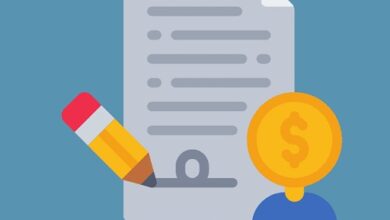What is Creative Commons purpose benefits Elements types
What Is Creative Commons?
Creative Commons is a term that refers both to the organization and to the licenses formulated by its members.
Let’s start with the non-profit organization , which operates all over the world providing legal instruments for free.
Its idea is to standardize the sharing permission regarding an authorial work .
The expression authorial work describes any creation of an intellectual nature, such as music, movies, texts, books.
“Creative Commons helps you legally share your knowledge and creativity to build a more just, accessible and innovative world. We unlock the full potential of the internet to drive a new era of development, growth and productivity.”
Now, let’s talk about what a Creative Commons license is.
In fact, there are six main licenses offered by the organization coordinating the project, each with its limitations.
Once a material is licensed through the initiative, it can be shared or modified under specific legal terms.
Want to understand better about the different licenses and how Creative Commons is used?
Just follow the next topics.
How Did Creative Commons Come About?
The organization coordinating the project was founded in 2001 by Lawrence Lessig, Hal Abelson and Eric Eldred, based in the US city of San Francisco.
The first version of Creative Commons licenses became available in December 2002, when it was released in the United States.
Licenses are currently at version 4.0 .
The licenses were inspired by two concepts: copyleft and free software.
Copyleft
Copyleft is, in a way, the opposite of the famous copyright – the copyright that covers any intellectual work.
According to art. 7 of the Copyright Law :
“Protected intellectual works are creations of the spirit, expressed by any means or fixed in any support, tangible or intangible, known or invented in the future.”
Once completed, the work has this legal protection , which requires the author’s prior approval in order to be distributed, published or modified.
This dynamic made sense until the mid-20th century, when the distribution of intellectual and artistic productions was restricted to different companies.
Writers had to turn to a publishing house to publish their books, while musicians, singers and musical groups had to submit to record labels.
Acting as intermediaries, these companies chose which works deserved to be published , assuming the risk arising from the costs of production and distribution.
If they were successful, several copies would be sold, resulting in a profit for the companies.
If not, they would bear the loss of products rejected by the public.
Until the 1970s, production companies operated according to the logic of scarcity , encouraging consumers to purchase their books, records and films under the pretext that there were only a few copies available.
Thus, it was possible to raise prices, as fans would compete for a copy of the work of their favorite author or artist.
However, this scenario changed from the 1980s onwards, when the audience began to have access to devices capable of copying the works.
But the profound changes came in the following decade, when the world followed the popularization of the internet and personal computers.
In this scenario, copyright rules made it difficult to share excerpts or complete materials, which could support the construction of innovations and the multiplication of knowledge.
The idea of copyleft is born from this context, formulating viable legal alternatives so that the author allows the use of his work according to what he wants, without harming the users.
In other words, copyleft makes use of the copyright legislation itself to give greater freedom to the author and to those who want to use their materials.
Free Software
The concept of free software, on the other hand, is opposed to proprietary software, which has its source code and use restricted to a corporation.
The movement began in the 1980s, when the activist Richard Stallman structured the GNU project, with the purpose of developing a computer program that could be read, modified and redistributed freely.
Since the 1990s, this project has been promoted by the Free Software Foundation, which grants the GPL (General Public License) to software that follows its principles, such as the four essential freedoms :
- Freedom #0 : Run the program for any purpose
- Freedom #1 : Study the program to understand how it works and modify it, adapting the solution to your needs
- Freedom #2 : Redistribute copies to help others
- Freedom #3 : Improve the software and make those improvements available so the community benefits from them.
Both ideals – copyleft and free software – were used to create Creative Commons, which establishes the legal and legal conditions for the use, adaptation and distribution of intellectual works.
What Is The Main Purpose Of Creative Commons?
The main objective of the project is to give authors, whether companies or individuals, simple tools that allow the exchange of “all rights reserved” (copyright) for “ some rights reserved ” (copyleft).
Imagine, for example, that an educator has written a small manual with exercises that facilitate classroom learning , which has been published and acquired by some colleagues.
In a short time, a small community of teachers has access to the manual, available both in print and in e-book.
This community plans to share the material, but under the Copyright Act, each person needs prior authorization from the author, which complicates redistribution.
But, by adhering to one of the Creative Commons licenses, this authorization is already granted under the chosen terms.
Thus, teachers and any other individual will be able to make use of the manual, without breaking the law or subject to legal proceedings.
What Are The Benefits Of The Creative Commons License?
The initiative benefits both authors and users, reconciling their purposes regarding a work.
Here are some advantages of using Creative Commons.
Presentation In Three Formats
The licenses exist in three different languages : one for laymen, a document in legal terms and a version in programming language (HTML code).
The first is summarized and explains, in a simple way, how the license works.
The second consists of a legal document aligned with the norms of each country, serving as legal support.
And the third confers a mark on digital documents licensed under Creative Commons, enabling computers to identify them.
Set Of Works For Various Uses
The repositories licensed by the project help to disseminate knowledge and culture, providing scientific studies, texts, music, films and other artistic compositions.
In addition to being redistributed and copied, there are authors who encourage creativity by allowing modifications through remixing and editing.
Gratuity
The adhesion to any of the licenses does not require the payment of any amount by the author or third parties who use the work.
In this way, there is no discrimination or impediment to access by people who cannot afford fees and other costs.
Simplicity
Legal norms are usually written in a formal language specific to the area, which makes it difficult for lay people to understand them .
To overcome this barrier, the Creative Commons project maintains simple written summaries, in addition to an easy process for those who want to insert licenses into their works.
It is therefore not necessary to consult a lawyer or specialist to understand what the permissions are about and adhere to one of them.
Protection Of The Author’s Moral Rights
It is important to point out that licenses do not extinguish copyrights, but lessen their restrictions.
Although the work may be modified or used in new materials, the author remains the holder of the right to claim his authorship, and the transfer of authorship is prohibited.
Validity In Over 100 Countries
We can say that Creative Commons has global validity, being approved by most nations in the world.
This advantage eliminates the need for licensing in each country where a work is accessed, reproduced, or distributed.
Local Action
Despite being present in a number of States, the organizations that coordinate the project adapt the licenses to the context and legal system of each territory.
They are also available in the official language of each nation.
Creative Commons Elements
The licenses made available by the initiative are based on four key elements.
The most basic is Attribution (BY) , which is present in all six Creative Commons licenses.
It represents the preservation of the author’s moral rights, requiring that any type of use must be accompanied by the due credits.
The project provides an option for anyone who wants to fully release access and modifications to their work, leaving it in the public domain.
In this case, the author does not request credits or any rights over the work, that is, he waives the Attribution.
The second element restricts the production of works from the first work, being referred to by the acronym ND (No to derivative works) .
Downloads, copies, redistribution and use can be made, however the author must authorize any modification to the original material.
Symbolized by the acronym NC, Non-Commercial use is another essential element for licensing under Creative Commons standards.
As the name suggests, the author does not allow the use of his work for commercial purposes – in other words, for activities that have profit as an objective.
The fourth element has an interesting role, requesting a compensation for people who compose a new work from alterations, adaptations or remixing (elaboration of new versions) of a work.
Called Share Alike or Share Alike (SA) , it is free to perform, copy, redistribute, and modify the original work.
Understand Creative Commons License Types
There are six most common license types , all of which give credit to the author – Attribution or BY.
The other three elements include different restrictions on authorizations , represented by their acronyms:
- NC: Non-commercial use
- ND: Does not allow the production of derivative works
- SA: Requires derivative works to obtain the same license as the original material.
See details about them below.
Attribution (CC BY)
This is the authorization with the least restrictions within the project.
Attribution only requires that credits be given to the author , allowing the work to be redistributed, adapted, remixed and served as a basis for new works.
Use for any purpose, including commercial, is permitted.
CC BY is of interest, for example, to an amateur singer or instrumentalist, who needs to flexibly promote their work in order to gain popularity.
Therefore, he makes music available to potential fans and even to radio stations, who will make commercial use of his works.
Attribution-Share Alike (CC BY-SA)
It allows third parties to create, adapt and remix from the intellectual work, as long as they give credit to the author and use the same license for new works.
Like CC BY, this authorization makes it possible to use materials for commercial and non-commercial purposes – which means that reproductions and creations that incorporate them also allow this.
CC BY-SA is the choice of popular platforms such as Wikipedia that benefit from adding new material in a collaborative way .
Attribution-No Derivations (CC BY-ND)
This is the specific concession for those who wish to see their work redistributed for commercial or non-commercial purposes, however, without any modification.
The CC BY-ND allows the transfer of the work, as long as it is complete and unaltered.
Attribution-Non-Commercial (CC BY – NC)
In addition to redistributing, others may adapt, remix and build upon the licensed work, as long as their activities are non-commercial .
The author must receive the credits, however, the derivative works are not obliged to choose this same license.
Attribution-Non-Commercial-Share Alike (CC BY-NC-SA)
Interested individuals may base themselves on a work to compose new works , make adaptations or remixed versions, provided they meet three conditions.
The first is to cite the author; the second, not to use the work in commercial activities.
Finally, the resulting works must be licensed with CC BY-NC-SA.
Assignment-No Derivatives-No Derivatives (CC BY-NC-ND)
If the author only wants to allow the full sharing of the work, without modifications , this is the recommended license.
CC BY-NC-ND authorizes redistribution with credits to the author, preventing commercial use, remixing and alterations.
How Is Creative Commons Used?
To use the licenses correctly, just follow the guidelines for each one.
Works using this system are marked with a seal , indicating the abbreviations of the authorization, or with the name of the license at the bottom of the page, as in Wikipedia.
How To Get Creative Commons License?
In fact, the licensed materials are already released for use by other individuals who, in turn, need to follow the sharing rules.
If you find a video marked CC BY-ND, you can make commercial use of it or not, but without modifying.
Let’s say the idea is to insert the material into a presentation of your company, which will be redistributed to the partners.
Along with the video or link to the video, it is important to include:
- the video title
- Author name and profile page (to give credit)
- Source (e.g. YouTube or Vimeo), including a link to the original content
- Share license, with link to the Creative Commons page that describes it.
How To Make Your Work Available On Creative Commons
By making your work licensed by the project available, you reinforce a collaborative culture and the construction of a free internet .
It’s easy to choose a license.
Start by going to this page and answering two simple questions:
- Allow adaptations of your work to be shared?
- Allow commercial uses of your work?
Combined, the answers generate each of the licenses we explained above.
Also remember to choose a partner platform that makes it possible to insert the Creative Commons seal.
You can find the updated list of partner platforms on this project page .




